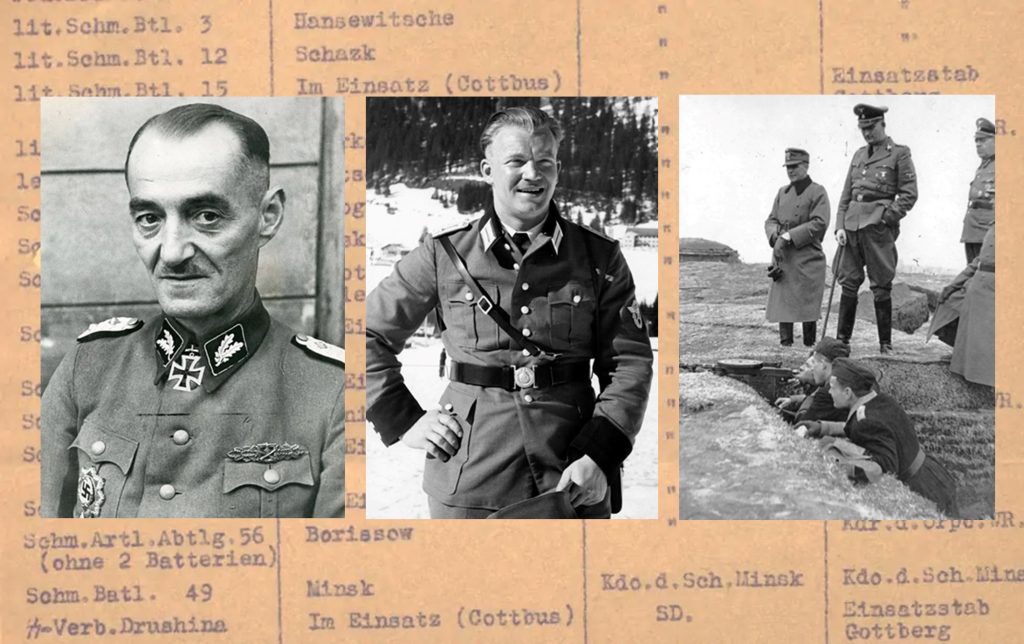The Ukrainian auxiliary police in Kyiv and adjacent areas, pt. 2: Scholarship versus propaganda
By Daniil Sytnyk
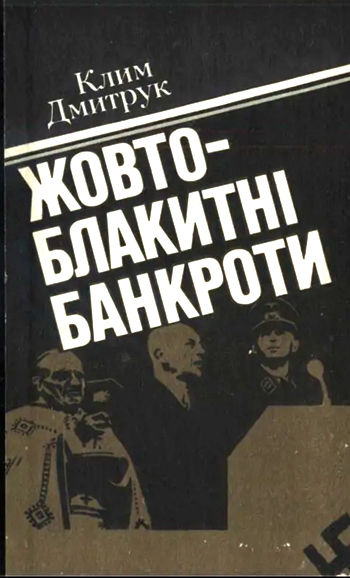
During his speech at a meeting of the St. Petersburg International Economic Forum on 17 June 2023, President Putin claimed that during the Second World War, one and a half million Jews were killed in Ukraine, "first and foremost, at the hands of Banderites." He also requested the screening of a video clip from a television program hosted by the Kremlin propagandist Dmitry Kiselyov, who was supposed to confirm the "crimes of the Banderites." There is every indication that the various chronologically and contextually unconnected video clips did not reveal anything new to Russian television viewers. In the poignant manner that is so utterly typical of Russian propaganda, Kiselyov declared once again that OUN members were directly involved in the mass shootings of Jews in Babyn Yar on 29–30 September 1941 and that afterward, some of them formed the Ukrainian police, specifically the 115/62nd and 118/63rd battalions of the auxiliary police, the latter taking part in the burning of the Belarusian village of Khatyn. The concluding speech about "the Banderites' depraved brutality and sadism toward defenseless people," which "shock researchers" to this very day, featured descriptions of tortures that were displayed in photographs. [1]
The "OUN/collaboration with the Germans/crimes" triangle has become an integral part of the political instrumentalization of historical scholarship in the Russian Federation. In examining the history of Ukrainian collaborationist formations, Russian journalists deliberately focus viewers' and readers' attention on their complicity in acts of anti-Jewish violence. In view of the fact that OUN members were often the creators of police detachments on the territory of Ukraine, the causes of this violence are explained almost exclusively as the destructive influence of the ideas of Ukrainian integral nationalism. In disseminating completely unsupported or even preposterous theories about the liquidation of Ukrainian Jewry, mostly "at the hands of Banderites" — claims that can be refuted at the first reading of scholarly literature [2] — Russian instrumentalizers seek to create a hypertrophied image of Ukrainian collaboration as a phenomenon of exceptional substance. [3]
What was the OUN's impact on the police? Was Ukrainian collaboration unique? Were its crimes an exception? In this part of my study, I examine several myths surrounding the history of the Ukrainian auxiliary police.
Тraditions of instrumentalizing the topic of collaborationism
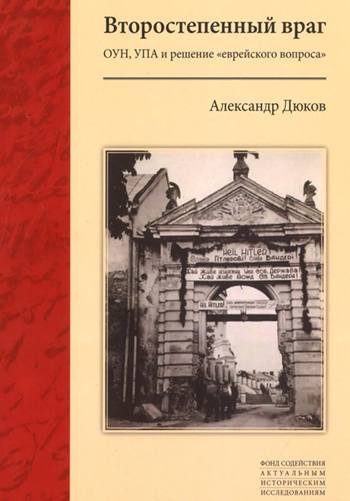
The persecution by the Nazis, their allies, and wartime collaborators has become an integral part of the history of postwar Europe. The change of political regimes was accompanied by the need to legitimize every new government in the eyes of the local population. The trials of representatives of toppled regimes were a mandatory element of this process. [4] During the open trials in Soviet Ukraine in the 1940s and 1950s, it was the Germans and their allies who usually ended up in the dock. However, trials of Soviet collaborators took place mostly behind closed doors. The sparse mentions in open sources of the time were marked by the traditional criminalization of collaborators (called "unreliable elements," "criminals," "kulaks," etc.) or by the emphasis placed on their affiliation with Ukrainian nationalism. Similarly, the goal of marginalization was not only to conceal the actual scale of cooperation with the Germans (nearly one million Soviet citizens served in the military and police forces of the Third Reich) but also to equate the liberation struggle of the Ukrainian insurgent movement, which was taking place at the time in Western Ukraine, with the recently defeated Nazi state. In tarring with the brush of Nazism, all members of the Ukrainian liberation movement without exception, the Soviets also sought to prove the legitimacy of their right to suppress these independentist aspirations.
In the USSR, research on the cooperation between local populations and the German occupation government was strictly regulated and censored, and only a limited number of people had access to archives and special collections. In the 1960s–1980s, a literary current appeared in the "political diatribe" genre, which aimed to "expose the crimes of bourgeois nationalists." Against the backdrop of increased tension during the Cold War, these political pamphlets focused on the activities of the OUN, the UPA, and the Galicia Division and were created for one specific purpose: to accuse the entire Ukrainian diaspora of crimes against humanity and the Western countries to which they had immigrated — of providing a cover for these "criminals." The representatives of this literary current, who were sometimes active members of the KGB, ascribed criminality to any and all Ukrainian independentist aspirations. [5] According to one such author, Yevstafii Halsky, a Ukrainian KGB officer (whose writings appeared under the pseudonym Klym Dmytruk), the auxiliary police was composed of political opponents of the Soviet regime: "The Nazis recruited former Petliurites, White Guardists, kulaks, and, of course, OUN freaks experienced in 'wet jobs' [assassinations] to participate directly in these punitive organs. The Nazis created police units from the ranks of OUN bandits and saboteurs, [and] selected provocateurs and perpetrators of terrorist acts." [6]
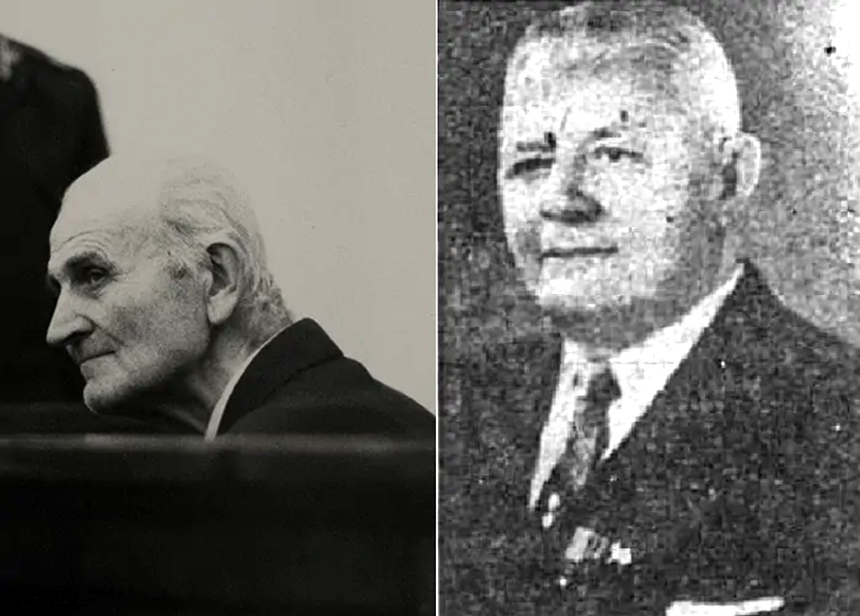
The Russian historical discourse mostly inherited Soviet propaganda narratives. Today, instead of discrediting Ukrainian émigré circles, a pejorative lexicon and accusations about the spread of "neo-Nazi" ideas are used to vilify the government and population of independent Ukraine. One of the most ambitious creators of the hypertrophied image of "Ukrainian neo-Nazism" and its identification with the ideology of the OUN is Aleksandr Dyukov. His Historical Memory Foundation, which he founded in 2008, has published dozens of works examining the involvement in war crimes of members of the Ukrainian and Baltic national liberation movements. Dyukov's book Vtorostepennyi vrag: OUN, UPA i reshenie evreiskogo voprosa (Secondary Enemy: The OUN, the UPA, and the Solution of the Jewish Question), released by the Kremlin-controlled publishing house REGNUM, [7] equates Nazi Germany's consistently genocidal policies with certain facts pointing to the participation of OUN and UPA members in the Holocaust. In his view, "every now and then, there are attempts to ascribe the crimes of Baltic and Ukrainian nationalists to the Nazi Einsatzgruppen." [8] In taking cases of mass violence perpetrated by individual groups or members of the OUN and the UPA out of historical context, Dyukov does not set himself the goal of researching the questions of motive, cause, and course of the violence, which are key to current historiography. Moreover, he is not interested in the history of the Holocaust and collaboration. Instead, the aim of Dyukov's texts lies in criminalizing the entire Ukrainian (and not just Ukrainian) liberation movement. Furthermore, he proposes the completely neo-Soviet thesis that the very presence of any kind of liberation movement on the territory of the Soviet Union is nothing but "banditry," and its members — "traitors of the Fatherland." [9]
Although Dyukov's book is described as a monograph, it is easy to see that the narrative tropes and markers he utilizes differ little from official Russian propaganda. In the context of the current Russo-Ukrainian War and, as stated by Putin, the top-priority goals of Russia's military aggression against Ukraine, that is, "denazification," the question of the dangers that may lurk beneath the quasi-scholarship in which pro-government agents of influence engage is merely rhetorical.
The OUN's influence over the auxiliary police: the case of the Kyiv battalions
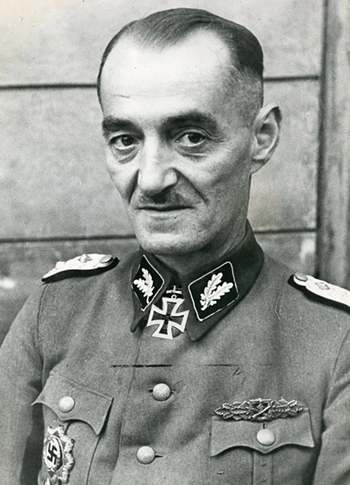
From the discourse of propaganda, we are steadily shifting to the academic dimension of this set of problems. Scholars agree that during the first six months of the German occupation of Ukraine, the members of both wings of the OUN served as the initiators and members of the Ukrainian police leadership in most large cities in western, central, and eastern Ukraine. Members of the OUN, occasionally at their own discretion, headed police subunits as long as the German administration tolerated their activities. Changes in the Germans' attitude were heralded by the persecution of the Banderites in the summer of 1941, and that fall, the Germans began dealing with the Melnykites. Along with the hunt for Ukrainian nationalists, the German authorities conducted a review of the auxiliary police personnel to remove functionaries whom they considered dangerous. However, research by historians specializing in regional and local studies reveals that OUN members continued to hold high positions in the police, notwithstanding the repressions of 1941–1942. [10] The level at which this influence was maintained remains an open question because historians usually study questions relating to police personnel only superficially, without any prosopographical focus. At the present time, there is not a single comprehensive study of the social dynamics and evolution of changes in the leadership of the Ukrainian police in at least one large, populated area, which could help to shed light on the question of the OUN's influence. From this perspective, I will focus here on the example of Kyiv.
The first members of the OUN(M) appeared in the Ukrainian capital almost immediately after the Germans arrived on 19 September 1941. Throughout the fall, they expanded their influence and went on to create an auxiliary police force headed mostly by their fellow party members or veterans of the Army of the UNR. The Kyiv Auxiliary Police Battalion (composed of members of the Melnykites' Bukovinian Battalion and former Soviet POWs), together with the district police service (city police), which included an investigations department, functioned throughout the city. Each of these formations was headed by an OUN(M) member and controlled by the regional police headquarters led by Oleksandr Kvitko, who had been a lieutenant colonel in the Army of the UNR. [11] Thus, the entire police administration in Kyiv was in the hands of Ukrainian nationalist circles, at least until the winter of 1941.
However, after the Germans launched a wave of repressions against the OUN, the supremacy of the Ukrainian nationalists receded quickly. By the first half of 1942, the Germans reorganized the sole existing "Ukrainian police," which they broke up into several auxiliary bodies subordinated to various German authorities. Here, I would like to focus only on the one that appears most often on the radar of proponents of the instrumentalization approach. I am talking about the so-called "closed units," above all, auxiliary police battalions. At the beginning of this article, I mentioned that the 115/62th and 118/63rd battalions were partly composed of fighters from the Melnykites' Bukovinian Battalion. It is these very circumstances that allow propagandists to claim that both these battalions were supposedly not only manned by Ukrainian nationalists but also under their full control. However, only one-third of the personnel could have been members of the OUN. For example, according to the memoirs of an officer of the 118/63rd Battalion, the 1st Company "was 75 percent composed of western Ukrainians […]. In the 2nd and 3rd companies, the majority was comprised of eastern Ukrainians; they were mostly former POWs as well as citizens whom the Germans wanted to take to Germany to work, and it was only service in our battalion that spared them this fate." [12]

As early as the second half of 1942, a large number of former Red Army officers were recruited to the Kyiv police. By this time, OUN members had lost their exclusive representation in the leadership of both battalions. For example, the permanent Ukrainian commander of the 118/63rd Battalion was Kostiantyn Smovsky, a former officer of the Army of the UNR and subsequently an émigré in interwar Poland. Nevertheless, according to the recollections of his subordinates, Smovsky was barely in command of the battalion: "He was old, and scarcely anyone paid any attention to him. All operations were mostly directed by [the battalion's chief of staff Hryhorii] Vasiura." [13] Unlike the elderly pro-Ukrainian commander, this twenty-eight-year-old Red Army lieutenant was demanding and brutal toward his subordinates. Back in 1937, he graduated from the Kyiv Military College of Communications and became a candidate member of the AUCP(B). [14]
In the historical literature, there is confusion surrounding the first commander of the 115/62nd Battalion, owing to the fact that he was in no way a "Ukrainian officer." [15] At the start of the war, an ethnic Russian named Stepan Dmitriev, a native of the Kuban, was captured by the Germans. Inventing a "correct" biography for himself and Ukrainizing his surname to "Dmytrenko," he joined a volunteer protection company manned by POWs. In July 1943, his exemplary service netted him a high-ranking position in the Kyiv-based 115/62nd Battalion. As commander of this formation, Dmitriev proved himself as an officer "with initiative." For example, on his orders, at least several dozen civilians, including children and elderly people, were shot in Belarus. [16] After Dmitriev's dismissal, which took place no earlier than November 1942, Hryhorii Zakhvalynsky, the former commandant of the Ukrainian protection police in Kyiv and member of the OUN(M), was appointed as Dmitriev's replacement. He held this post for less than a year, after which a German captain named Pohl became the new commander of the 115/62nd Battalion. [17]
The collective portrait of the company commanders of the 115/62nd Battalion is not homogeneous. The 1st Company was headed by Todor Ostapenko, a member of the Melnykites' Bukovinian Battalion; the commander of the 2nd Company was Oleksii Zarichansky, formerly a senior lieutenant in the Red Army; the 3rd Company was led by the French émigré Nikolai Nekrasov, a former captain of the Russian imperial army. [18] The personnel situation in the 118/63rd Battalion was similar. Osyp Vynnytsky, a Melnykite, headed the 1st Company. However, former Red Army officers were in command of the other two companies. Lieutenant Ivan Nariadko was commander of the 3rd Company. Ivan Shudra, commander of the 2nd Company, was dismissed at the beginning of 1943, most likely as a result of his anti-German position. (Shudra himself told his acquaintances that "sooner or later he will flee the battalion.”) Afterwards, this post was held by a Soviet lieutenant named Mykola Sandula, who was more loyal to the Germans. It is telling that a year later, when the battalion had become part of the 30th SS Division in France, Sandula was one of a handful of officers who refused to support the anti-German uprising. [19]
Various German bodies noted the resourcefulness and pro-German stance of former Soviet officers. For example, the former Red Army officer Volodymyr Havrylyshyn refused, along with Sandula, to take part in the rebellion. The slanderous denunciations that he regularly submitted to his German superiors in 1942–1943 led to the dismissal of at least three officers, including Dmitriev, commander of the 115/62nd Battalion. Another of the dismissed officers was publicly executed on suspicion of having planned to join the partisans. [20] However, Havrylyshyn was not the only pro-German officer. The fighters of the 115/62nd Battalion suspected Lieutenant Zarichansky, formerly of the Red Army and the new commander of the battalion's 2nd Company, of making denunciations because, by a strange coincidence, he was promoted immediately after the previous commander, a nationalist, was arrested. [21] Thus, it may be supposed that Red Army officers sometimes wielded more influence in the Nazi administration than their nationalist colleagues. According to policemen's testimonies, Zarichansky, commander of the 2nd Company of the 115/62nd Battalion, "was devoted to the Germans. In the summer of 1943, he donned civilian clothing [and] conducted intelligence missions aimed at uncovering partisans and individuals connected with them." [22] Sandula, commander of the 2nd Company of the 118/63rd Battalion, lodged together with German personnel and "enjoyed the special trust of the [German] chief of the battalion, [Major Erich] Körner." [23]
In addition to the 115/62nd and 118/63rd battalions, the 23rd Auxiliary Police Battalion, attached to the Security Police and the SD, was formed in Kyiv. It took part in the anti-partisan war in Belarus with the two other battalions. "Under the command of SS-Sturmbannführer Paul Radomski, who also held the post of commandant of the Syrets concentration camp, the police battalions were supposed to protect the camp perimeter. However, the leadership of the Security Police and the SD wanted to turn it into a combat-ready unit. Thus, in January 1943, Radomski was replaced by SS-Hauptsturmführer Willibald Regitschnig, who had more military skills. [24] The situation surrounding the leading personnel of the battalion differs from all the above-mentioned "closed units." Unlike the paired leadership in other units, where each German commander was assigned a Ukrainian one, all the highest-ranking commanders, without exception, in the 23rd Battalion were Germans. [25] The battalion's Ukrainian personnel were only platoon commanders, who, by their ethnic and socioeconomic backgrounds, did not differ from the rank-and-file soldiers, forcibly conscripted youths between the ages of eighteen and twenty-four, from the Poltava and Kyiv districts. [26] I was unable to discover any OUN members among the fighters of this battalion.
Thus, in the case of the "closed units," it would be a mistake to talk about the OUN's sole influence from the summer of 1942 onwards. The "personnel hodgepodge" in the battalions reflects the Nazis' typical imperialistic logic of "divide and conquer," for, along with nationalists, former Soviet officers were appointed as company commanders, and the latter were sometimes more loyal to the Germans. Generally speaking, extant sources reveal that, as of early 1943, only 30 percent of the highest-ranking officers in Kyivan "closed units" were nationalists. Nevertheless, in the interest of fairness, it must be noted that the actual command of all police bodies was in the hands of the Germans. Even though Ukrainian policemen had some room for initiative, it was the Germans who defined the range and nature of their tasks.
The ethnic mosaic of the "Khatyn killers"
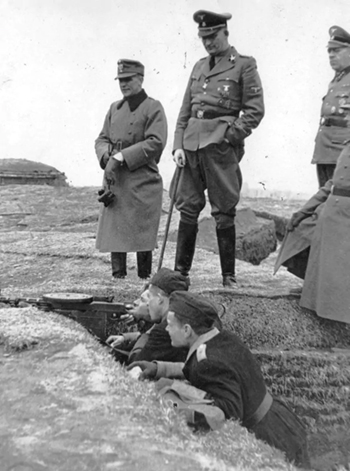
A collection of documents entitled Khatyn Killers: The 118th Ukrainian Police Battalion in Belarus, 1943–1944, was published in 2018, with the participation of Dyukov, the instrumentalizer mentioned earlier. Its focus is the burning of the Belarusian village of Khatyn by the fighters of the 1st and 3rd companies of the 118/63rd Auxiliary Police Battalion and SS-Sonderbataillon Dirlewanger, whose name does not figure in the title. The collection contains documents on Khatyn and the punitive nature of the anti-partisan war in Belarus. Since the "shock force" of the punitive operations was not composed of German but of Latvian, Lithuanian, and Ukrainian units [27], as the compilers of the collection state, it would be worthwhile to discuss this in more detail.
Various agents of influence often point to the Khatyn massacre as an exclusively Ukrainian crime (forgetting about SS-Sonderbataillon Dirlewanger), as well as a typical example of the "OUN's fascism." However, this was not a unique phenomenon during the Second World War. Regions where partisan warfare was widespread often became sites of mass crimes masked as anti-partisan operations. [28] In Belarus, for example, the geographic conditions (huge forested and swampy tracts) had a positive impact on the concentration of significant groupings of Soviet underground members. Taking the growing partisan threat seriously, the occupation authorities realized that German units alone would not solve the problem. Thus, the decision was made to deploy all serviceable auxiliary police forces from other regions, particularly Ukraine, to Belarus. The majority of the most well-known partisan operations was conducted by auxiliary police fighters who were part of the combat group (Kampfgruppe von Gottberg) led by Curt von Gottberg, SS and Police Leader of the General District White Ruthenia. Von Gottberg himself established the modus operandi for all his German and non-German subordinates: with no hesitation and investigations, to execute "bandits, local people suspected of banditry and abetting bandits, Jews, gypsies [sic], horsemen [sic], and minors." [29] As we can see, the arbitrary interpretation of the term "sympathizers of bandits" allowed the Germans to include in this category ordinary inhabitants of villages near which partisans were spotted. This is precisely how events unfolded around Khatyn.
On the morning of 22 March 1943, a group of policemen from the 118/63rd Battalion, departing on their latest mission, was ambushed. On a stretch of the Plyeshchanitsy-Lahoysk road, Soviet partisans shot the group, killing Hans Welke, the German commander of the battalion's 1st Company and former Olympic champion. After the successful attack, the partisans withdrew to one of the closest populated areas — Khatyn. In response, the German leadership declared the village a "bandit" one. In the euphemistic language of the day, this meant that Khatyn was slated for destruction, along with part (or all) of its inhabitants as "abettors of bandits." The order was issued to the troops of the Kyivan 118/63rd Battalion and SS-Sonderbataillon Dirlewanger stationed nearby. Upon their arrival, they encountered fierce resistance, but the police forces managed to smash the Soviet partisans. After the battle, the troops of both units burned Khatyn to the ground, together with its 149 inhabitants. According to an internal report drawn up by the commander of the 118/63rd Battalion, some locals who had abandoned the village before the battles managed to survive. [30]
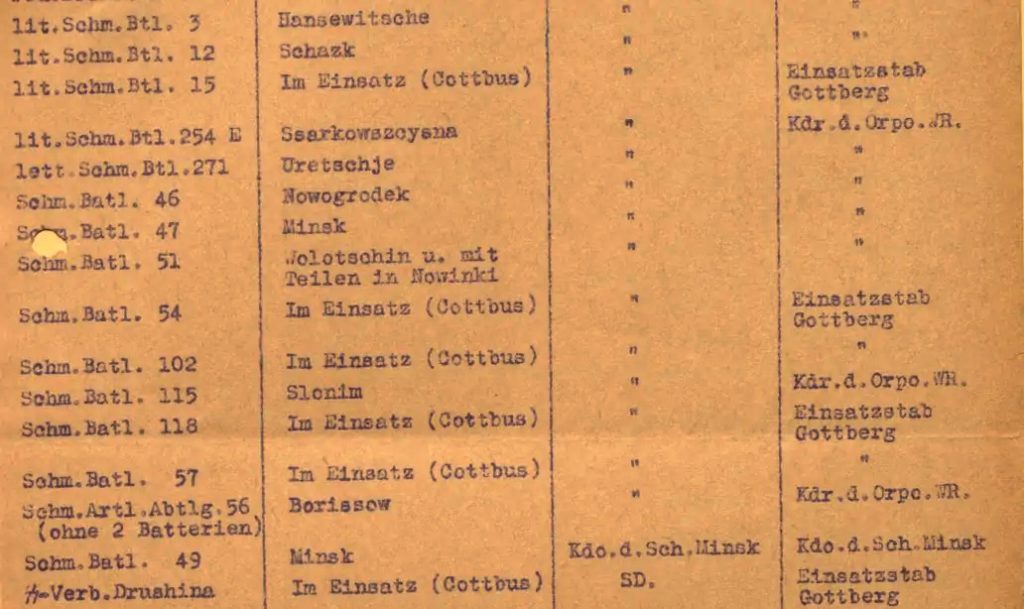
The Khatyn case is not unique but symptomatic of the events that unfolded in Belarus in 1942–44. Mass killings of civilians took place alongside combat operations, as statistical data attest. Some historians estimate that, out of the 345,000 people killed in Belarus during the anti-partisan war, only about 10 percent could have belonged to the resistance movement. Such assessments are made not only based on casualty figures compiled by the Germans but also on the number of weapons captured from partisans — they represented a tiny fraction of the presumed partisan force. Another indicator that allows us to assert the punitive nature of the anti-partisan operations is the abnormally small number of combat losses declared by the Germans. For example, according to von Gottberg's announcement of the results of a single operation, Operation Cottbus (May–June 1943), 9,796 partisans and their "abettors" were killed. At the same time, joint German and non-German forces recorded 128 fatalities. Thus, the ratio of German to Soviet losses was 1:50, respectively, which indicates the punitive nature of these operations more than the unrealistic effectiveness of the German and auxiliary forces. [31]
The composition of the participants in the punitive operations in Belarus is a question that merits separate attention. In addition to German units, the forces that were used in Operation Cottbus included the Russian SS unit "Druzhina" (SS-Verband "Drushina"), the 15th Lithuanian, and the Ukrainian 102nd and 118/63rd auxiliary police battalions. Although documents identify the 54th and 57th auxiliary police battalions as "Ukrainian," the real number of ethnic Ukrainian personnel in these units hardly exceeded 45 percent (the rest were Russians and Belarusians). [32] Operation Cottbus was preceded by preparatory measures in the form of two special operations in Minsk oblast codenamed "Daredevil" (Shybaiholova). During Daredevil-2 (1–10 May 1943), the core of the police forces was composed of fighters from SS-Sonderbataillon Dirlewanger, more than 40 percent of whose personnel were Russians, as of October 1942. [33] Ten days before the Khatyn massacre, the Dirlewanger troops conducted the next operation, as a result of which 21 partisans and 212 "abettors of bandits" were shot. In total, the unit under the command of Oskar Dirlewanger was responsible for murdering approximately 60,000 people. [34]
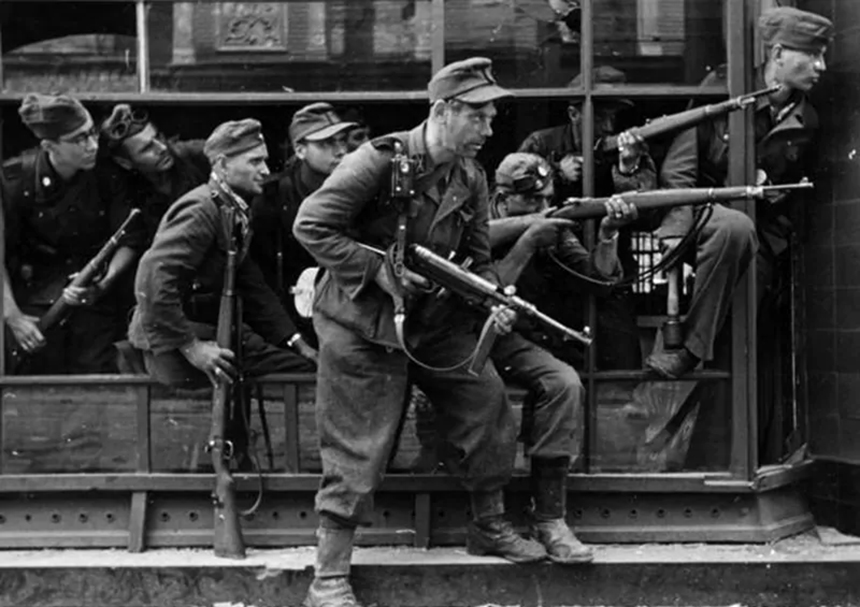
In Vitebsk oblast, the Ukrainian 23rd Auxiliary Police Battalion (attached to the SD), the "mixed" 57th Auxiliary Police Battalion, Russian companies from SS-Sonderbataillon Dirlewanger, and the Russian Sturm-Brigade RONA (Russian National Liberation Army) took part in Operation Operation Frühlingsfest (Spring) (April–May 1944). [35] The RONA unit, better known as the Kaminski Brigade (named in honor of SS-Brigadeführer Bronislav Kaminski), numbered between three and four thousand former Russian policemen from the so-called Lokot Autonomous District (Briansk, Orel, and Kursk oblasts of the RSFSR). The brigade members "distinguished themselves" not only during the punitive operations in Belarus but also took part in crushing the Warsaw Uprising in August 1944. [36]
So, who were the actual "Khatyn killers"? If we examine this question not literally but in the context of the implementation of the Nazis' genocidal policies, the participants of the anti-partisan operations in Belarus were not just German and Ukrainian but Russian, Belarusian, Baltic, and other non-German military-police detachments. The direct perpetrators of the Khatyn massacre, whom the Russian authors of the above-mentioned collection identify exclusively in the title as Ukrainians (and sometimes as nationalists) from the 118/63rd Battalion, could easily have included Russians from SS-Sonderbataillon Dirlewanger. These findings are not intended to justify the punitive activities of Ukrainian collaborationist units; on the contrary, I urge historians to investigate all perpetrators of crimes, regardless of their ethnic background or political orientation. This will foster a better understanding of mass violence.
The (un)averageness of the Ukrainian case?
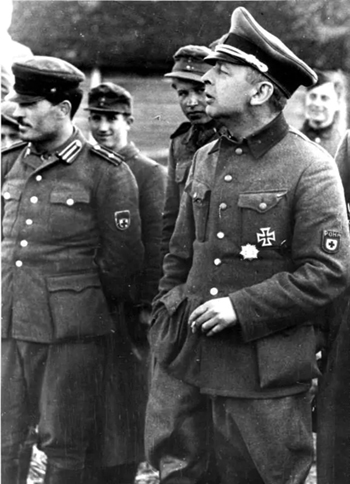
After a public lecture that I delivered on the eve of Russia's full-scale invasion of Ukraine, a Russian woman in the audience (who had not lived in Russia for a long time) asked me the following question: "Why were Ukrainian nationalists the most brutal of all policemen?" Throughout my lecture, I had sought to describe the diversity among auxiliary police personnel. Thus, I decided to repeat several theses about the universality of brutality characteristic of people of different ideological, ethnic, and social backgrounds. My explanation did not win her over because she was totally convinced about the primordial sadism of Ukrainian nationalists.
In this situation, it is difficult not to note the results of the instrumentalization approach. Ukrainian (and Baltic) collaboration is a hot topic for the Russian infosphere. Except for a few historians, everyone else, especially pro-government media resources, avoids mentioning Russian (and Belarusian) collaborationism. The selective nature of materials, which refer exclusively to Ukrainian collaborators and fail to mention others, leads to the formation of stereotypes and prejudice. Thus, in order to shed light on the non-existence of "exceptional" Ukrainian collaborationism, I offer several examples below from the history of its Russian and Belarusian counterparts.
First of all, Belarusian and Russian military and political groups, like the members of the OUN, took an active part in organizing the occupation apparatus during the Second World War. In Russia's Smolensk district, the Belarusian nationalist Dźmitry Kasmovič, one of the organizers of the Belarusian Independence Party (BPN), was in charge of forming auxiliary police detachments. [37] The BPN's programmatic documents stipulated that Belarusian military-police formations were to be ethnically homogeneous, once Poles and Russians were excluded (here, we can see certain parallels with the OUN's instructions to create ethnically Ukrainian detachments at the beginning of the German-Soviet War). [38] Émigrés, including Franz Kushal (Francišak Kušal), also joined these police formations. After serving in the Armed Forces of Poland during the interwar period, Kushal was in charge of officers' courses for members of military-police formations in Minsk in 1942. [39] In regions strongly influenced by the traditions of the Don Cossacks (southern Russia), auxiliary police bodies were mostly composed of and headed by White émigrés and local veterans of Anton Denikin's Russian Volunteer Army. [40]

But did Russians and Belarusians — representatives of nationalist organizations and veterans of the revolutionary period — take part in mass violence? Nikolai Sverchkov, a former officer of the Russian imperial army who was in command of the auxiliary police in the city of Smolensk in 1942–1943, personally shot local Roma. [41] The head of the political department of the Smolensk police was Nikolai Alferchik, a member of the National Labor Alliance of the New Generation (NTSNP). On the orders of the deputy mayor, who was also a member of the NTSNP, Alferchik was placed in charge of the shootings of approximately two thousand Smolensk Jews on 15 June 1942. [42] Some historians estimate that NTSNP members gained a foothold in important administrative positions in forty cities and towns. [43]
The ideological platform of the NTSNP had a clear far-right and antisemitic character. Prejudices about the Jewish roots of Bolshevism and their interdependence permeated the views of Russian nationalists. On the whole, the myth of the "Judeo-Commune" was a kind of Zeitgeist prevalent among European right-wing radical and militaristic movements during this period. [44] On the eve of the Second World War, the mood in White émigré circles had much in common with Nazi propaganda. Petr Krasnov, a leader of the White movement during the Civil War in Russia, voiced his support for German aggression: "I ask […] to convey to all the Cossacks […] that this war is not against Russia but against communists, Jews, and their henchmen who are trading in Russian blood." [45] One of those who headed to the USSR as a volunteer was Rostislav Zavadsky, a descendant of a White émigré. Assigned to the Belgian volunteer corps known as the Walloon Legion, he arrived in the Donbas, where he was appointed police commandant in the town of Shcherbynivka (Donetsk oblast) in January 1942. Zavadsky's personal papers bristle with anti-Soviet and antisemitic writings. His private correspondence with his wife contains a [Russian-language] poem with the following lines:
Those former activists,
Yids and communist executioners,
They have no mercy from me.
(They don't even ask for it,
When the horned ones carry off
Their souls to hell) […] [46]
In Radchenko's view, around this time (winter-spring 1942), police detachments under Zavadsky's command hunted down and murdered Jews in Shcherbynivka district. [47] Thus, his poem may be viewed as a reflection on his direct participation in the Holocaust.
In addition to politically motivated individuals, all auxiliary police officers, that is, people of different ages, social statuses, and education levels, were equally involved in acts of mass violence. Throughout the occupation of Belgorod and its vicinities, the local Russian police frequently shot leading Soviet party activists, Jews, and mentally ill people. One such episode took place on the premises of a factory that produced reed-slab building materials on 5 February 1942, when the entire Belgorod police force, headed by police chief Belanov and his deputy, Fedorovsky, took part in shooting at least six hundred people, including children and the elderly. [48] Members of the Russian auxiliary police in the city of Cherkessk (Kuban region) conducted arrests, convoyed prisoners, guarded mass shooting sites, and took part in executing more than three thousand local residents, mostly Jews. [49] However, the Kuban and the Russian-Ukrainian borderland were not the only mass shooting sites. Similar events also took place in the German-occupied northern regions of Russia. When the Germans entered the town of Staraia Russa (Novgorod oblast), Russian policemen compiled a list of residents of Jewish nationality, who were shot shortly afterward. [50]
The Belarusian auxiliary police was not known for its humaneness toward its prewar Jewish neighbors. When the chief of the Barysaw raion police (Minsk oblast) ordered the commander reporting to him to dispatch fifteen policemen to take charge of resettling Jews in the ghetto, "instead of them, 17 appeared." [51] The latter incident clearly indicates that some local policemen eagerly sought out any opportunities to join anti-Jewish operations rather than attempting to miss out on them. Thanks to such operations, policemen enriched themselves by appropriating the property of murdered people. The "intoxication" of power led to an increase in the degree of brutality when perpetrators treated violence as entertainment. Vladimir Senko, commander of the Niasviž police (Minsk oblast), recounted how, during an operation conducted in June 1942, he shoved Jews out of the second and third stories of buildings. [52] In another incident, the guards at the Koldichevo concentration camp, where approximately 22,000 people were killed, "entertained themselves" by forcing prisoners to have sex in the camp dining hall. During the sex acts, the guards beat the prisoners mercilessly with cudgels and then killed them. On the orders of [the Belarusian policeman Nikolai] Kalka, the bodies were thrown out of a window." [53]
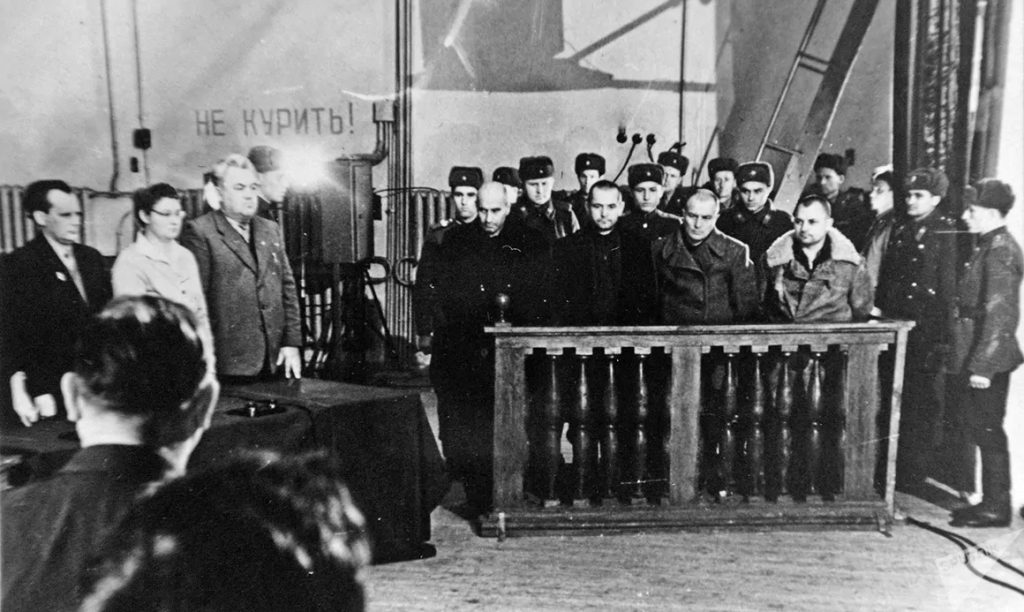
These fragmentary testimonies thus undermine the instrumentalization narrative about the "depraved brutality and sadism of the Banderites." It is highly unlikely that even a single OUN member was among the Belarusian policemen at the Koldichevo camp who abused Jewish prisoners. Hence, both brutality and anti-Jewish violence in general cannot be explained by exclusively ideological factors, especially nationalistic convictions. In order to understand policemen's motivations (the choice to serve in the police, the choice to kill or to save, to adapt to circumstances, etc.), it is necessary to research the contexts that conditioned one act or another. The well-known historian Alexander Prusin applied this method in his study of Ukrainian policemen based in the Kyiv General District. He divided them into three sociopsychological types: "political activists" (ideological collaborationists: nationalists, émigrés, anti-Soviet local inhabitants); "eager conformists" (careerists and activists who adapted to the political realities no matter what regime was in power); and "local perpetrators" (functionaries who ended up in the police because they were forced to do so directly or indirectly). It is telling that the smallest group turned out to be "political activists" (13 out of 82 individuals). [54]
The reflections presented here refute the near-sacred universality of explanations (particularly for Russian propaganda) for the violent activities of policemen under the influence of the ideas of Ukrainian integral nationalism. In reality, there is no single answer to the question of why the members of all the auxiliary police forces discussed in this article took part in killings approved by the German authorities. With a vast range of motives that varied depending on the time, place, and circumstances, people of different — sometimes diametrically opposed — sociopsychological profiles succeeded in cooperating within the framework of a single community (for example, communists and members of nationalist organizations, as the case of the Kyivan battalions demonstrates). Furthermore, if not for the specific circumstances of the German occupation, it is unlikely that anything could have united them in peacetime.
The photographs used in this article are from the author's private archive and open sources.
Endnotes
2 For the composition of the participants in the Babyn Yar shootings, see Aleksandr Kruglov and Andrei Umanskii, Babii Iar: Zhertvy, spasiteli, palachi (Dnipro: Ukrainskii institut izucheniia Kholokosta "Tkuma," 2019). For some quantitative indicators of people killed by various German military and police structures in Ukraine, see Wolfgang Curilla, Die deutsche Ordnungspolizei und der Holocaust im Baltikum und in Weißrußland 1941–1944 (Paderborn, 2005), 791–817.
3 It is noteworthy that even in Western Ukraine (specifically Eastern Galicia) in the summer of 1941, when the largest number of cases of OUN involvement in mass anti-Jewish violence occurred, approximately 60 percent of all Jewish victims were killed by the Germans. See Kai Struve, "OUN(b), nimtsi ta antyievreis′ke nasyl′stvo," Ukraїna Moderna, no. 24 (2017): 255.
4 For a detailed discussion of this, see Tony Judt, Postwar: A History of Europe Since 1945 (New York: Penguin Press, 2005), 41–62.
5 Iryna Sklokina, “Radians′ka polityka pam’iati pro kolaboratsiiu periodu natsysts′koї okupatsiї iak instrument natsional′noї polityky: Rehional′nyi aspekt,” in Natsional′na ta istorychna pam’iat′: Zb[irnyk] nauk[ovykh] prats′, vyp. 5 (Kyiv: DP NVTs “Priorytety,” 2012): 121–24.
6 Klym Dmytruk, Zhovto-blakytni bankroty (Kyiv: Dnipro, 1982), 66.
7 In 2014, the REGNUM News Agency became a platform for waging an information war against Ukraine. On this, see Kristiina Müür et al., "Russian Information Operations against the Ukrainian State and Defence Forces: April–December 2014 in Online News," Journal of Baltic Security 2, no. 1 (2016): 28–71.
8 Aleksandr Dyukov, Vtorostepennyi vrag: OUN, UPA i reshenie “evreiskogo voprosa”: Monografiia (Moscow: REGNUM, 2008), 6.
9 For a brief discussion of Dyukov, the instrumentalization approach, and Dyukov's impact on historical scholarship, see Yuri Radchenko, Babyn Yar: A Site of Massacres, (Dis)remembrance and Instrumentalization.
10 For a subchapter and reference to this, see John-Paul Himka, Ukrainian Nationalists and the Holocaust: OUN and UPA's Participation in the Destruction of Ukrainian Jewry, 1941–1944 (Ibidem Press, 2021), 344–351.
11 Anatolii Kabaida, “1941”: Kalendar-al′manakh “Novoho shliakhu,” ed. P. Dorozyns′kyi (Toronto, 1991), 53–54.
12 HDA SBU, f. 68, spr. 10, vol. 1, fol. 89.
13 HDA SBU, f. 68, spr. 10, vol. 1, fol. 168
14 HDA SBU, f. 68, spr. 10, vol. 1, fol. 93.
15 For references to this, see Ivan Dereiko, "Diial′nist′ 115/62-ho ukraïns′koho batal′ionu shutsmanshaftu na terenakh Bilorusi ta Frantsiї v 1942–1944 rr.," Naukovi zapysky NaUKMA: Istorychni nauky 21 (2003): 30.
16 HDA SBU, f. 5, spr. 55730, fols. 18–24, 105–6, 122–24.
17 HDA SBU, f. 11, spr. 766, no. 1, fol. 80v.
18 HDA SBU, f. 5, spr. 55730, fol. 32.
19 HDA SBU, f. 11, spr. 766, no. 2, fols. 50–52. On Shudra and Sandula, see HDA SBU, f. 5 spr. 55730, fol. 30v; Roman Ponomarenko, “Ukrainskii miatezh: 30-ia diviziia SS vo Frantsii,”: Warspot — obozrenie voennykh novostei (Accessed 4 August 2023).
20 HDA SBU, f. 5, spr. 55730, fols. 33v–34.
21 P. Honcharenko, “Z istoriї odnoho kurenia (Litopysna khronika P. Honcharenka, literaturnyi zapys Zynoviia Knysha),” Samostiina Ukraїna, nos. 3–4 (1974): 38.
22 HDA SBU, f. 11, spr. 766, no. 1, fol. 82.
23 “№ 88: Iz protokola doprosa N. A. Franchuka g. Grodno 28 iiulia 1973 g.,” in Ubiitsy Khatyni: 118-i ukrainskii batal′on okhrannoi politsii v Belorussii, 1943–1944 gg.; Sbornik dokumentov, comp. I. A. Valakhanovich et al. (Moscow: Izdatel′stvo "Piatyi Rim," 2018), 192.
24 For his biographical details, see USHMM, RG-06.025, reel 14, frame 473–79 [TsA FSB, Osobyi fond, Н-19091, vol. 12, fols. 2–8].
25 USHMM, RG-06.025, reel 14, frame 523–26 [TsA FSB, Osobyi fond, Н-19091, vol. 12, fols. 53–56].
26 HDA SBU, f. 11, spr. 773, no. 5, fols. 181–85, 213–15.
27 Aleksei Dyukov and Vyacheslav Selemenov, introduction to Ubiitsy Khatyni, 7.
28 For a comparative history of Nazi mass killing in Belarus, Yugoslavia, and Greece, see Alex J. Kay, Empire of Destruction: A History of Nazi Mass Killing (Yale University Press, 2021), 173–91.
29 Cited in Hannes Heer, "The Logic of the War of Extermination: The Wehrmacht and the Anti-Partisan War," in War of Extermination: The German Military in World War II, 1941–1944, ed. Hannes Heer and Klaus Naumann (New York: Berghahn Books, 2000), 113.
30 “№ 34: Donesenie komandira 118-go politseiskogo okhrannogo batal′ona nachal′niku SS i politsii Borisovskogo uezda o napadenii partizan na batal′on u d. Guby i unichtozhenii d. Khatyn′ [12 aprelia 1943 g.],” in Ubiitsy Khatynia, 68–69.
31 Kay, Empire of Destruction, 177–83.
32 BArch, RS 3-36/8, Bl. 149 (“Die Höhere SS- und Polizeiführer Rußland-Mitte und Weißruthenen, Kräfteübersicht [Stand vom 1 Juni 1943]”). On the 54th, 57th, and other "Ukrainian" battalions that were formed in Belarus, see Ivan Dereiko, Mistsevi formuvannia nimets′koї armiї ta politsiї u Raikhskomisariati "Ukraїna" (1941–1944 roky) (Kyiv: Instytut istoriї Ukraїny NAN Ukraїny, 2012), 77. The ratio of Ukrainians to Russians and Belarusians is calculated based on HDA SBU, f. 5, spr. 65509, vol. 5, fols. 282–86.
33 Dmitrii Zhukov and Ivan Kovtun, Okhotniki za partizanami: Brigada Dirlevangera (Moscow: Veche, 2013), 119, 126, 216.
34 Ibid., 198, 418.
35 NARA, T354, roll 651, frames 582–83 (“Einsatzbefehl für Unternehmen 'Frühlingsfest‘ [11.04.1944]”); ibid., frame 557–58 (“Sonderbefehl, Betr.: Einsatz der Sicherheitspolizei und des SD. bei Unternehmen “Frühlingsfest” und Belehrung für die Truppe [10.4.1944]”).
36 On participation in the crushing of the Warsaw Uprising, discussion around Kaminski's death, and the subsequent role of RONA, see Dmitrii Zhukov and Ivan Kovtun, 29-ia grenaderskaia diviziia SS "Kaminskii" (Moscow: Veche, 2009), 169–203.
37 Dz′mitry Kasmovich, Za vol′nuiu і suverennuiu Belarus′ (Vilnius: Gudas, 2006), 142.
38 Ibid., 97.
39 Ibid., 98.
40 Iurii Tsurganov, Beloemigranty i Vtoraia mirovaia voina: Popytka revansha, 1939–1945 (Moscow: ZAO Tsentrpoligraf, 2010), 140.
41 “№ 14: Iz pokazanii B. G. Men′shagina (24 ianvaria 1968 g.),” in Boris Men′shagin, Vospominaniia, Pis′ma, Dokumenty, comp. Pavel Polian (Moscow and St. Petersburg: Nestor-Istoriia, 2019), 793.
42 Ivan Gribkov and Dmitrii Zhukov, Osobyi shtab “Rossiia” (Moscow: Veche, 2011), 101–2.
43 Ibid., 100.
44 Iurii Radchenko, “Ukraїns′ka politsiia ta Holokost na Donbasi,” Ukraїna Moderna, no. 24 (2017): 93.
45 Cited in Tsurganov, Beloemigranty, 54.
46 Cited in Radchenko, “Ukraїns′ka politsiia,” 107.
47 Ibid.
48 Bogdan Martynov, "Natsistskii okkupatsionnyi rezhim i kollaboratsionizm na territorii iuzhnykh i iugo-vostochnykh raionov Kurskoi oblasti (oktiabr′ 1941–avgust 1943 gg.)," Candidate of Historical Sciences dissertation (Belgorod, 2017), 61–66.
49 “Iz prigovora № 582 Voennogo tribunala Piatigorskogo garnizona po obvineniiu P <…>; dobrovol′no postupivshego na sluzhbu v nemetskie karatel′nye voiska, sluzhivshego nachal′nikom ugolovnogo otdela Cherkesskoi oblastnoi politsii. 22–23 noiabria 1944 g.”, in Bez sroka davnosti: Prestupleniia natsistov i ikh posobnikov protiv mirnogo naseleniia na okkupirovannoi territorii RSFSR v gody Velikoi Otechestvennoi voiny; Kabardino-Balkarskaia Respublika; Karachaevo-Cherkesskaia Respublika; Respublika Adygeia; Sbornik dokumentov, ed. E. P. Malysheva et al. (Moscow: Kuchkovo pole, 2020), 378.
50 Johannes Due Enstad, Soviet Russians under Nazi Occupation: Fragile Loyalties in World War II (Cambridge: Cambridge University Press, 2018), 64, 84.
51 Leonid Rein, The King and the Pawns: Collaboration in Byelorussia during World War II (New York: Berghahn Books, 2011), 269.
52 Ibid., 272.
53 Ibid., 302.
54 Aleksandr Prusin, “Ukrainskaia politsiia i Kholokost v general′nom okruge Kiev, 1941–1943: Deistviia i motivatsii,” Holokost і suchasnist′. Studiї v Ukraїni і sviti, no. 2 (2007): 31–59.
 Daniil Sytnyk is a graduate student at the Yukhymenko Family Doctoral School of the National University of Kyiv-Mohyla Academy ([email protected]). He is the recipient of numerous scholarships, including the Mandel Center Alumni of the Ukrainian Summer Programs (Mandel Center for Advanced Holocaust Studies, United States Holocaust Memorial Museum). His research interests include the study of collaborationism in Eastern and Southern Europe during the Second World War; the structure of the SS and the police of the Third Reich; the history of the Holocaust. He is currently working on his doctoral dissertation, "The Ukrainian Auxiliary Police in the City of Kyiv: Formation, Activity, and Cadre Personnel, 1941–1945."
Daniil Sytnyk is a graduate student at the Yukhymenko Family Doctoral School of the National University of Kyiv-Mohyla Academy ([email protected]). He is the recipient of numerous scholarships, including the Mandel Center Alumni of the Ukrainian Summer Programs (Mandel Center for Advanced Holocaust Studies, United States Holocaust Memorial Museum). His research interests include the study of collaborationism in Eastern and Southern Europe during the Second World War; the structure of the SS and the police of the Third Reich; the history of the Holocaust. He is currently working on his doctoral dissertation, "The Ukrainian Auxiliary Police in the City of Kyiv: Formation, Activity, and Cadre Personnel, 1941–1945."
Originally appeared in Ukrainian @Ukraina Moderna
This article was published as part of a project supported by the Canadian non-profit charitable organization Ukrainian Jewish Encounter.
Translated from the Ukrainian by Marta D. Olynyk.
NOTE: UJE does not necessarily endorse opinions expressed in articles and other materials published on its website and social media pages. Such materials are posted to promote discussion related to Ukrainian-Jewish interactions and relations. The website and social media pages will be places of information that reflect varied viewpoints.







